boot FIAT QUBO 2008 1.G User Guide
[x] Cancel search | Manufacturer: FIAT, Model Year: 2008, Model line: QUBO, Model: FIAT QUBO 2008 1.GPages: 202, PDF Size: 3.43 MB
Page 127 of 202
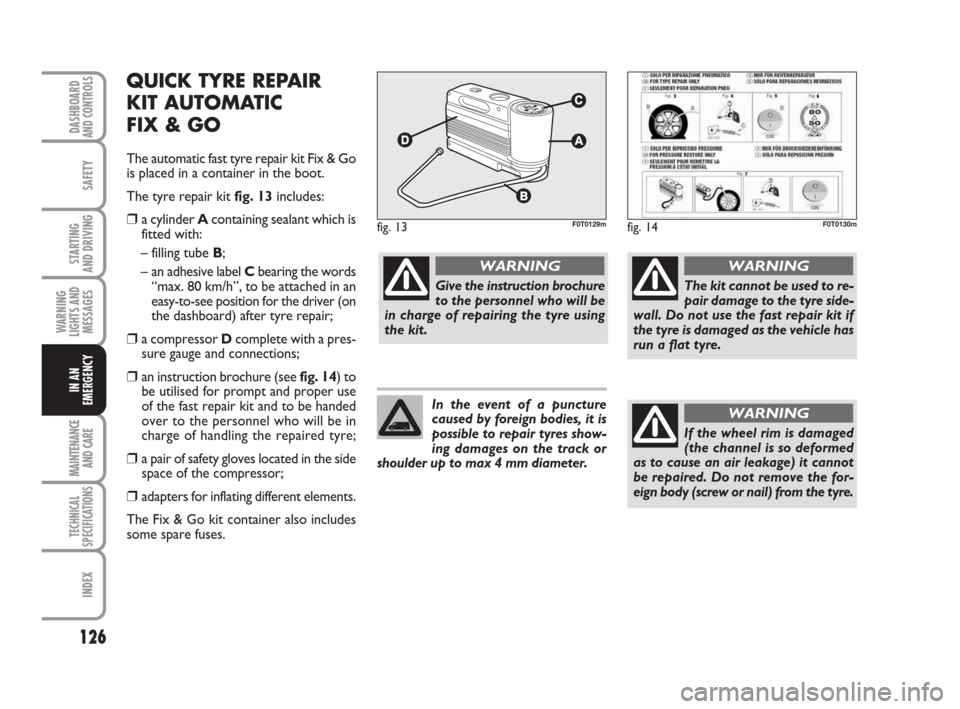
126
SAFETY
MAINTENANCE
AND CARE
TECHNICAL
SPECIFICATIONS
INDEX
DASHBOARDAND CONTROLS
STARTING
AND DRIVING
WARNING
LIGHTS AND
MESSAGES
IN AN
EMERGENCY
QUICK TYRE REPAIR
KIT AUTOMATIC
FIX & GO
The automatic fast tyre repair kit Fix & Go
is placed in a container in the boot.
The tyre repair kit fig. 13includes:
❒a cylinder A containing sealant which is
fitted with:
– filling tube B;
– an adhesive label Cbearing the words
“max. 80 km/h”, to be attached in an
easy-to-see position for the driver (on
the dashboard) after tyre repair;
❒a compressor Dcomplete with a pres-
sure gauge and connections;
❒an instruction brochure (see fig. 14) to
be utilised for prompt and proper use
of the fast repair kit and to be handed
over to the personnel who will be in
charge of handling the repaired tyre;
❒a pair of safety gloves located in the side
space of the compressor;
❒adapters for inflating different elements.
The Fix & Go kit container also includes
some spare fuses.
fig. 13F0T0129mfig. 14F0T0130m
Give the instruction brochure
to the personnel who will be
in charge of repairing the tyre using
the kit.
WARNING
The kit cannot be used to re-
pair damage to the tyre side-
wall. Do not use the fast repair kit if
the tyre is damaged as the vehicle has
run a flat tyre.
WARNING
If the wheel rim is damaged
(the channel is so deformed
as to cause an air leakage) it cannot
be repaired. Do not remove the for-
eign body (screw or nail) from the tyre.
WARNINGIn the event of a puncture
caused by foreign bodies, it is
possible to repair tyres show-
ing damages on the track or
shoulder up to max 4 mm diameter.
119-150 Fiorino GB 1ed 21-10-2008 15:05 Pagina 126
Page 141 of 202
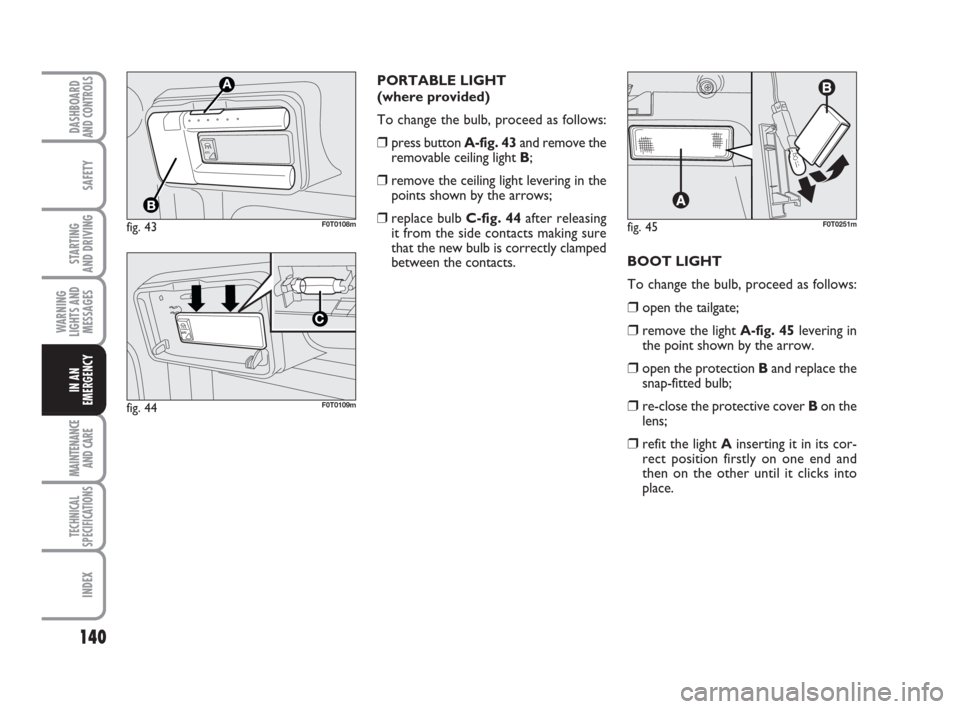
140
SAFETY
MAINTENANCE
AND CARE
TECHNICAL
SPECIFICATIONS
INDEX
DASHBOARDAND CONTROLS
STARTING
AND DRIVING
WARNING
LIGHTS AND
MESSAGES
IN AN
EMERGENCY
PORTABLE LIGHT
(where provided)
To change the bulb, proceed as follows:
❒press button A-fig. 43and remove the
removable ceiling light B;
❒remove the ceiling light levering in the
points shown by the arrows;
❒replace bulb C-fig. 44after releasing
it from the side contacts making sure
that the new bulb is correctly clamped
between the contacts.
fig. 43
AU
TO
F0T0108m
fig. 44
A
UTO
F0T0109m
BOOT LIGHT
To change the bulb, proceed as follows:
❒ open the tailgate;
❒remove the light A-fig. 45levering in
the point shown by the arrow.
❒open the protection Band replace the
snap-fitted bulb;
❒re-close the protective cover Bon the
lens;
❒refit the light Ainserting it in its cor-
rect position firstly on one end and
then on the other until it clicks into
place.
fig. 45F0T0251m
119-150 Fiorino GB 1ed 21-10-2008 15:05 Pagina 140
Page 148 of 202
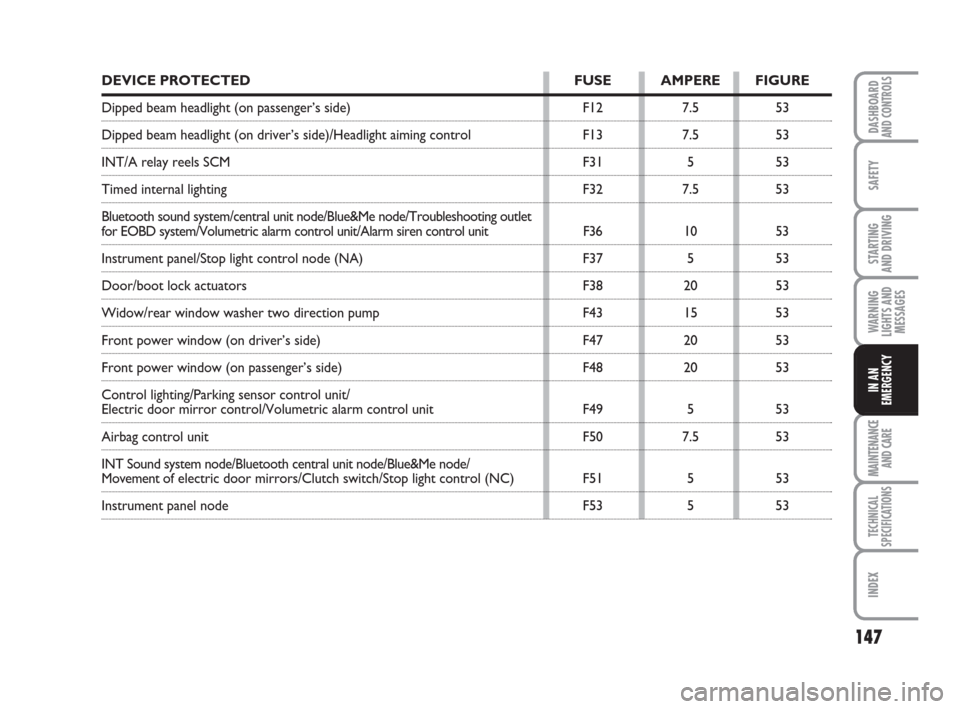
147
SAFETY
MAINTENANCE
AND CARE
TECHNICAL
SPECIFICATIONS
INDEX
DASHBOARDAND CONTROLS
STARTING
AND DRIVING
WARNING
LIGHTS AND
MESSAGES
IN AN
EMERGENCY
DEVICE PROTECTED FUSE AMPERE FIGURE
Dipped beam headlight (on passenger’s side) F12 7.5 53
Dipped beam headlight (on driver’s side)/Headlight aiming control F13 7.5 53
INT/A relay reels SCM F31 5 53
Timed internal lighting F32 7.5 53
Bluetooth sound system/central unit node/Blue&Me node/Troubleshooting outlet
for EOBD system/Volumetric alarm control unit/Alarm siren control unit F36 10 53
Instrument panel/Stop light control node (NA) F37 5 53
Door/boot lock actuators F38 20 53
Widow/rear window washer two direction pump F43 15 53
Front power window (on driver’s side) F47 20 53
Front power window (on passenger’s side) F48 20 53
Control lighting/Parking sensor control unit/
Electric door mirror control/Volumetric alarm control unit F49 5 53
Airbag control unit F50 7.5 53
INT Sound system node/Bluetooth central unit node/Blue&Me node/
Movement of electric door mirrors/Clutch switch/Stop light control (NC) F51 5 53
Instrument panel node F53 5 53
119-150 Fiorino GB 1ed 21-10-2008 15:06 Pagina 147
Page 151 of 202
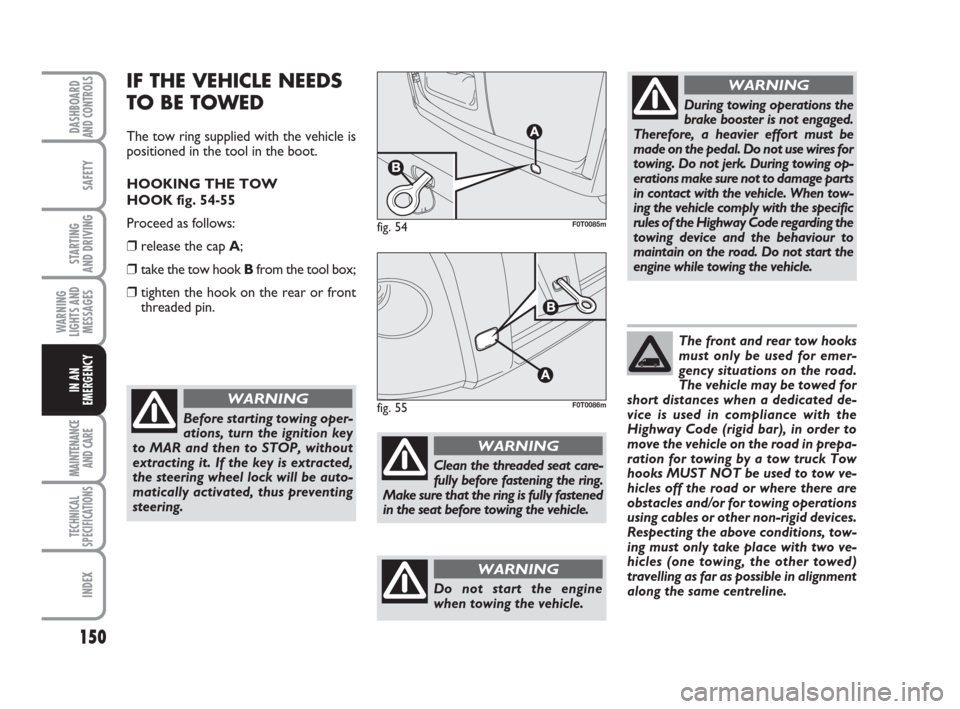
150
SAFETY
MAINTENANCE
AND CARE
TECHNICAL
SPECIFICATIONS
INDEX
DASHBOARDAND CONTROLS
STARTING
AND DRIVING
WARNING
LIGHTS AND
MESSAGES
IN AN
EMERGENCY
IF THE VEHICLE NEEDS
TO BE TOWED
The tow ring supplied with the vehicle is
positioned in the tool in the boot.
HOOKING THE TOW
HOOK fig. 54-55
Proceed as follows:
❒release the cap A;
❒take the tow hook Bfrom the tool box;
❒tighten the hook on the rear or front
threaded pin.
fig. 54F0T0085m
fig. 55F0T0086m
Before starting towing oper-
ations, turn the ignition key
to MAR and then to STOP, without
extracting it. If the key is extracted,
the steering wheel lock will be auto-
matically activated, thus preventing
steering.
WARNING
During towing operations the
brake booster is not engaged.
Therefore, a heavier effort must be
made on the pedal. Do not use wires for
towing. Do not jerk. During towing op-
erations make sure not to damage parts
in contact with the vehicle. When tow-
ing the vehicle comply with the specific
rules of the Highway Code regarding the
towing device and the behaviour to
maintain on the road. Do not start the
engine while towing the vehicle.
WARNING
Clean the threaded seat care-
fully before fastening the ring.
Make sure that the ring is fully fastened
in the seat before towing the vehicle.
WARNING
Do not start the engine
when towing the vehicle.
WARNING
The front and rear tow hooks
must only be used for emer-
gency situations on the road.
The vehicle may be towed for
short distances when a dedicated de-
vice is used in compliance with the
Highway Code (rigid bar), in order to
move the vehicle on the road in prepa-
ration for towing by a tow truck Tow
hooks MUST NOT be used to tow ve-
hicles off the road or where there are
obstacles and/or for towing operations
using cables or other non-rigid devices.
Respecting the above conditions, tow-
ing must only take place with two ve-
hicles (one towing, the other towed)
travelling as far as possible in alignment
along the same centreline.
119-150 Fiorino GB 1ed 21-10-2008 15:06 Pagina 150
Page 154 of 202
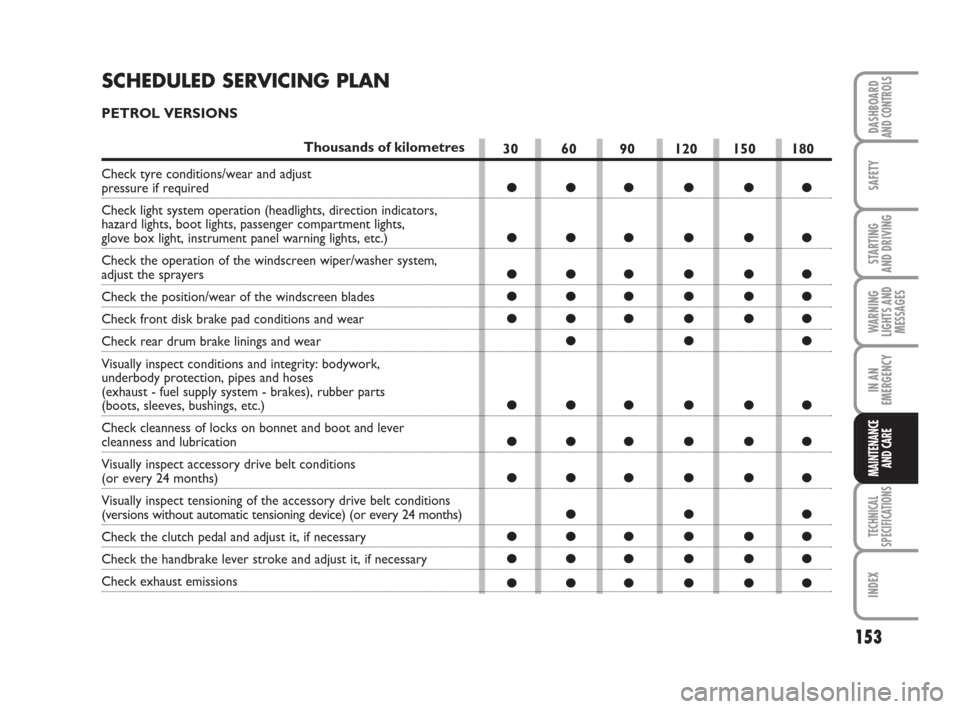
153
SAFETY
TECHNICAL
SPECIFICATIONS
INDEX
DASHBOARDAND CONTROLS
STARTING
AND DRIVING
WARNING
LIGHTS AND
MESSAGES
IN AN
EMERGENCY
MAINTENANCE
AND CARE
30 60 90 120 150 180
●●●●●●
●●●●●●
●●●●●●
●●●●●●
●●●●●●
●●●
●●●●●●
●●●●●●
●●●●●●
●●●
●●●●●●
●●●●●●
●●●●●●
SCHEDULED SERVICING PLAN
PETROL VERSIONS
Thousands of kilometres
Check tyre conditions/wear and adjust pressure if required
Check light system operation (headlights, direction indicators,
hazard lights, boot lights, passenger compartment lights,
glove box light, instrument panel warning lights, etc.)
Check the operation of the windscreen wiper/washer system,
adjust the sprayers
Check the position/wear of the windscreen blades
Check front disk brake pad conditions and wear
Check rear drum brake linings and wear
Visually inspect conditions and integrity: bodywork,
underbody protection, pipes and hoses
(exhaust - fuel supply system - brakes), rubber parts
(boots, sleeves, bushings, etc.)
Check cleanness of locks on bonnet and boot and lever
cleanness and lubrication
Visually inspect accessory drive belt conditions
(or every 24 months)
Visually inspect tensioning of the accessory drive belt conditions
(versions without automatic tensioning device) (or every 24 months)
Check the clutch pedal and adjust it, if necessary
Check the handbrake lever stroke and adjust it, if necessary
Check exhaust emissions
151-172 Fiorino GB 1ed 21-10-2008 15:01 Pagina 153
Page 156 of 202

155
SAFETY
TECHNICAL
SPECIFICATIONS
INDEX
DASHBOARDAND CONTROLS
STARTING
AND DRIVING
WARNING
LIGHTS AND
MESSAGES
IN AN
EMERGENCY
MAINTENANCE
AND CARE
30 60 90 120 150 180
●●●●●●
●●●●●●
●●●●●●
●●●●●●
●●●●●●
●●●
●●●●●●
●●●●●●
●●
●●
●●●●●●
●●●●●●
DIESEL VERSIONS
Thousands of kilometres
Check tyre conditions/wear and adjust pressure, if required
Check light system operation (headlights, direction indicators,
emergency lights, boot lights, passenger compartment lights,
glove box light, instrument panel warning lights, etc.)
Check the operation of the windscreen wiper/washer system,
adjust the sprayers
Check the position/wear of the windscreen blades
Check front disk brake pad conditions and wear
Check rear drum brake linings and wear
Visually inspect conditions and integrity: bodywork,
underbody protection, pipes and hoses
(exhaust - fuel supply system - brakes), rubber parts
(boots, sleeves, bushings, etc.)
Check cleanness of locks on bonnet and boot and lever
cleanness and lubrication
Visually inspect accessory drive belt conditions
Visually inspect tensioning of the accessory drive belt conditions
(versions without automatic tensioning device)
Check the handbrake lever stroke and adjust it, if necessary
Check exhaust emissions/smokiness
151-172 Fiorino GB 1ed 21-10-2008 15:01 Pagina 155
Page 158 of 202
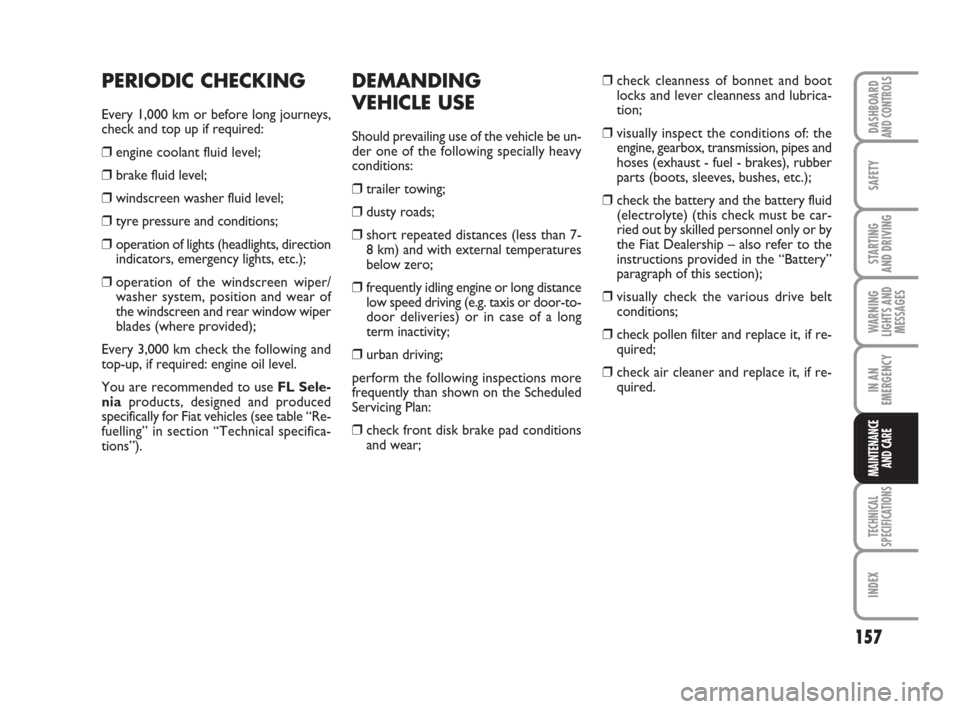
157
SAFETY
TECHNICAL
SPECIFICATIONS
INDEX
DASHBOARDAND CONTROLS
STARTING
AND DRIVING
WARNING
LIGHTS AND
MESSAGES
IN AN
EMERGENCY
MAINTENANCE
AND CARE
PERIODIC CHECKING
Every 1,000 km or before long journeys,
check and top up if required:
❒engine coolant fluid level;
❒brake fluid level;
❒windscreen washer fluid level;
❒tyre pressure and conditions;
❒operation of lights (headlights, direction
indicators, emergency lights, etc.);
❒operation of the windscreen wiper/
washer system, position and wear of
the windscreen and rear window wiper
blades (where provided);
Every 3,000 km check the following and
top-up, if required: engine oil level.
You are recommended to use FL Sele-
niaproducts, designed and produced
specifically for Fiat vehicles (see table “Re-
fuelling” in section “Technical specifica-
tions”).
DEMANDING
VEHICLE USE
Should prevailing use of the vehicle be un-
der one of the following specially heavy
conditions:
❒trailer towing;
❒dusty roads;
❒short repeated distances (less than 7-
8 km) and with external temperatures
below zero;
❒frequently idling engine or long distance
low speed driving (e.g. taxis or door-to-
door deliveries) or in case of a long
term inactivity;
❒urban driving;
perform the following inspections more
frequently than shown on the Scheduled
Servicing Plan:
❒check front disk brake pad conditions
and wear;❒check cleanness of bonnet and boot
locks and lever cleanness and lubrica-
tion;
❒visually inspect the conditions of: the
engine, gearbox, transmission, pipes and
hoses (exhaust - fuel - brakes), rubber
parts (boots, sleeves, bushes, etc.);
❒check the battery and the battery fluid
(electrolyte) (this check must be car-
ried out by skilled personnel only or by
the Fiat Dealership – also refer to the
instructions provided in the “Battery”
paragraph of this section);
❒visually check the various drive belt
conditions;
❒check pollen filter and replace it, if re-
quired;
❒check air cleaner and replace it, if re-
quired.
151-172 Fiorino GB 1ed 21-10-2008 15:01 Pagina 157
Page 186 of 202
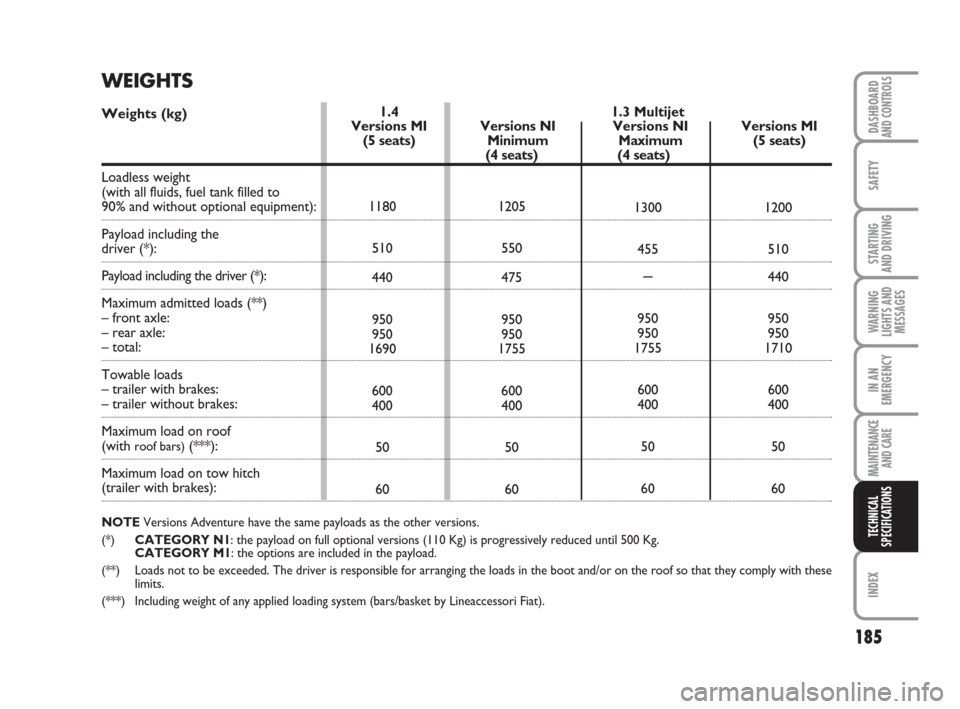
185
SAFETY
INDEX
DASHBOARDAND CONTROLS
STARTING
AND DRIVING
WARNING
LIGHTS AND
MESSAGES
IN AN
EMERGENCY
MAINTENANCE
AND CARE
TECHNICAL
SPECIFICATIONS
WEIGHTS
Weights (kg)
Loadless weight
(with all fluids, fuel tank filled to
90% and without optional equipment):
Payload including the
driver (*):
Payload including the driver (*):
Maximum admitted loads (**)
– front axle:
– rear axle:
– total:
Towable loads
– trailer with brakes:
– trailer without brakes:
Maximum load on roof
(with roof bars)(***):
Maximum load on tow hitch
(trailer with brakes):
NOTEVersions Adventure have the same payloads as the other versions.
(*)CATEGORY N1: the payload on full optional versions (110 Kg) is progressively reduced until 500 Kg.
CATEGORY M1: the options are included in the payload.
(**) Loads not to be exceeded. The driver is responsible for arranging the loads in the boot and/or on the roof so that they comply with these
limits.
(***) Including weight of any applied loading system (bars/basket by Lineaccessori Fiat).
1.4
Versions MI Versions NI
(5 seats) Minimum
(4 seats)
1180 1205
510 550
440 475
950 950
950 950
1690 1755
600 600
400 400
50 50
60 601.3 Multijet
Versions NI Versions MI
Maximum (5 seats)
(4 seats)
1300 1200
455 510
–440
950 950
950 950
1755 1710
600 600
400 400
50 50
60 60
173-193 Fiorino GB 1ed 21-10-2008 15:02 Pagina 185